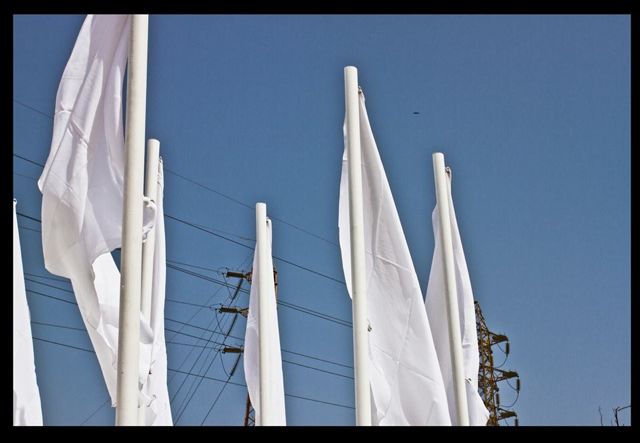Our author Aboubacar Demba Cissokho re-examines the eleventh edition of Dak'Art.

Dak'Art 2014 installation view. Image: Mame-Diarra Niang. © Mame-Diarra Niang
Dak’Art has established itself firmly on the map of art biennales around the globe. But after eleven editions, its future will depend on redefining its status and, accordingly, its financing.
The eleventh edition of the Biennale of Contemporary African Art (Dak’Art), which took place from 9 May to 8 June 2014, has beyond doubt cemented the event in the continent’s cultural calendar and confirmed Senegal’s leadership in the landscape of African art.
Dak’Art 2014 emphasized its uniqueness off the bat with the proposed theme of “Producing the common,” reminding us of art’s social and political role and the corresponding role of the artist who, by interrogating the material, is driven to respond to the core impulses of the society in which the artist is developing. The official selection of around sixty artists reflects the vision of the three curators who chose them on the strength of their adventurous artistic taste.
The Biennale’s practical organization did not change significantly, notwithstanding the innovations introduced by Babacar Mbaye Diop, the new secretary general, whose concern for his first edition was to give a more popular touch to the event, which many Dakar residents had perceived and experienced as an elitist affair.
In fact, Dak’Art did open up to another audience by incorporating improbable locations such as the campus of the Dakar’s Cheikh Anta Diop University (an exhibition of temporary works created with materials found on site), a major hospital’s psychiatric center, the prison, and even a zoo. Other notable novelties included the “Cultural Diversity” space, which enabled non-African artists to exhibit at “IN,” and the salon of African sculpture.
The future will tell whether those efforts had a real impact, but we can already say that the campaign was initially a lukewarm success for lack of an effective communication strategy, as the staff position responsible for that at the Biennale had been eliminated after three editions. As a result, the artist Amadou Daouda Ndiaye made the assertion that “Dakar isn’t bubbling, isn’t sparkling as in previous editions” in a forum published on May 9th in the Sud-Quotidien newspaper.
Hence the question from a national television reporter, who wondered aloud: “What’s happening with this Biennale? We have no idea what’s going on.” It’s true that, if you ask Dakar residents about their views of the event, you realize it’s not as well-known as one might think. The fact that art is considered “entertainment for the rich” certainly has something to do with it.
Some issues were apparent from the beginning. The international exhibition, the high point of the biennale, was opened to the public a day late at a difficult-to-reach “Biennale village.” The event’s promises were certainly kept, with more than fifty countries represented and more than 300 exhibits including the increasingly dynamic “Off” program, whose draw can be attributed to its convenience. The pavilions of Algeria and Morocco are located opposite the Place du Souvenir (Memory Square), offering proof that art and culture can converge.
If you add in the scientific panels, debates, exhibitions and tributes to missing artists, it’s an essential meeting point between art and culture in a country beset by a paradox that no one overlooks: the sore lack of a museum of contemporary art, addressed by Thérèse Thurpin Diatta, president of the biennale’s orientation committee, in her speech introducing the 11th edition.
Dak’Art is 24 years old, an age that you would expect to give it a new sense of momentum, a new level of status. The idea has been raised of establishing a foundation. This merits consideration alongside other avenues with the goal of giving the biennale financial independence, an administration subject to stringent management rules and an obligation to produce results. That is what it would take for the biennale to make a leap in quality paving the way to a brilliant future.
Based in Dakar, Aboubacar Demba Cissokho is a Senegalese cultural journalist. Since 2001 Cissokho has worked as a reporter for the Senegalese Press Agency (APS).
More Editorial